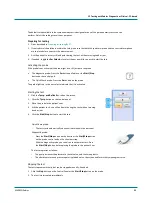
12 Testing with Zodiac Diagnostic or Clinical - PC-based
84
MADSEN Zodiac
The Quick Check probe:
2.
Press the probe against the patient's ear canal so
that a hermetic seal is achieved. The
measurement starts automatically.
3.
To stabilize the probe and to avoid blocking the
probe against the ear canal of the patient, grasp
the pinna and gently pull the pinna back and
slightly away from the patient's head.
–
For adults: pull the pinna upwards and back.
–
For infants and children: pull the pinna down-
wards and back.
The diagnostic probe:
4.
Place the shoulder strap on the shoulder of the
patient.
5.
To stabilize the probe and to avoid blocking the
probe against the ear canal of the patient, grasp
the pinna and gently pull the pinna back and
slightly away from the patient's head.
–
For adults: pull the pinna upwards and back.
–
For infants and children: pull the pinna down-
wards and back.
6.
Insert the probe in the patient's ear canal while
twisting the probe gently. When the probe is in
place, remove your hands carefully.
Quick Check probe placement
Diagnostic probe placement
7.
Make sure that the eartip fits well. This will
minimize the risk of blocking the probe tip against
the ear canal wall. A flat tympanogram together
with an abnormally small ear canal volume (ECV)
indicates that the probe is blocked.
A measurement will not auto start if the ear
canal volume reading is less than 0.1.
8.
Any leakage will interrupt the test. The probe will
indicate if there is a leak.
12.3
Tympanometry testing
You can record a tympanogram either as a separate measurement or as part of a diagnostic or screening sequence.
In a sequence, tympanometry is automatically followed by reflex testing.
Follow the steps for performing tympanometry as a single test with the sequence function disabled.
















































